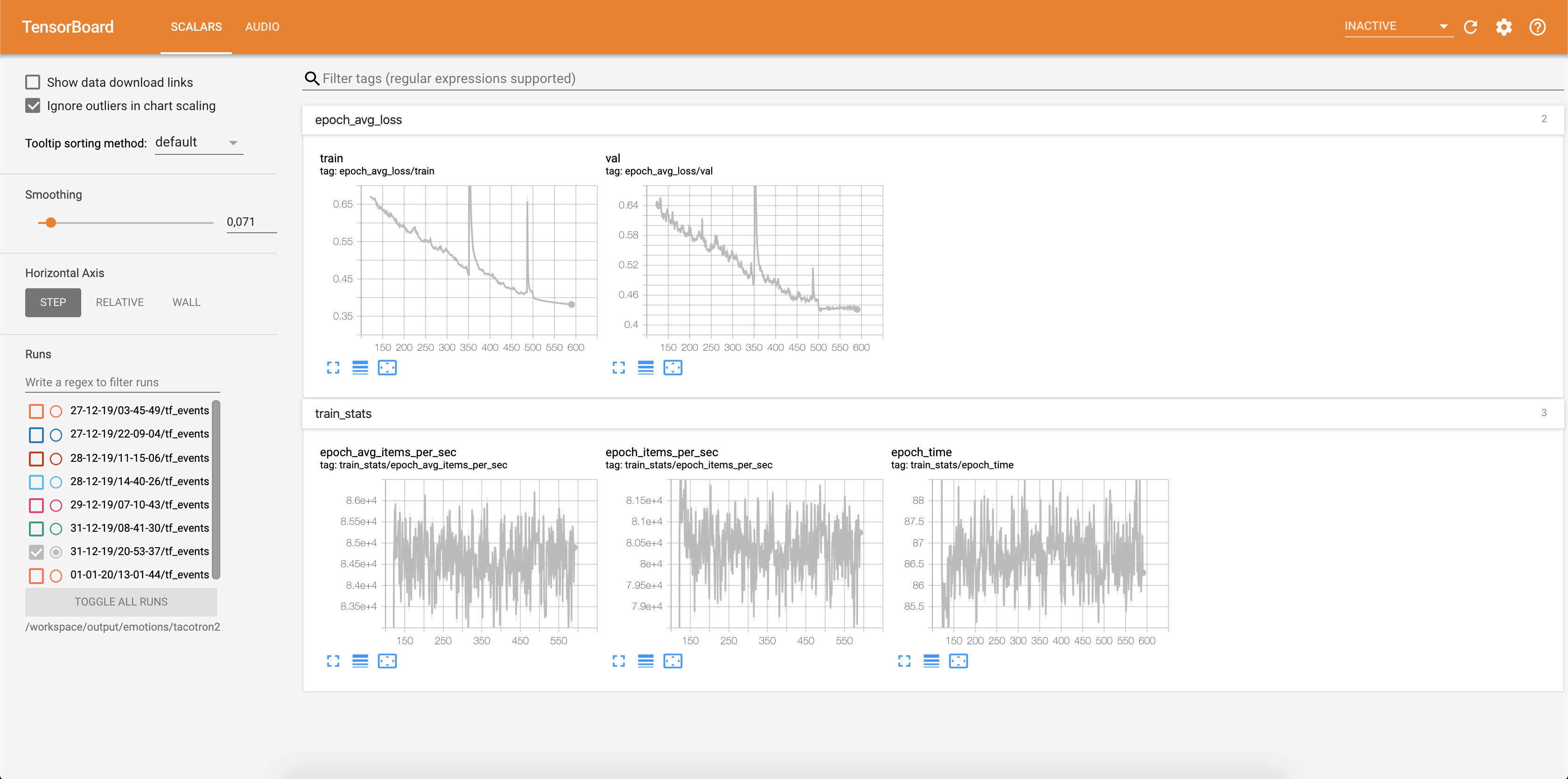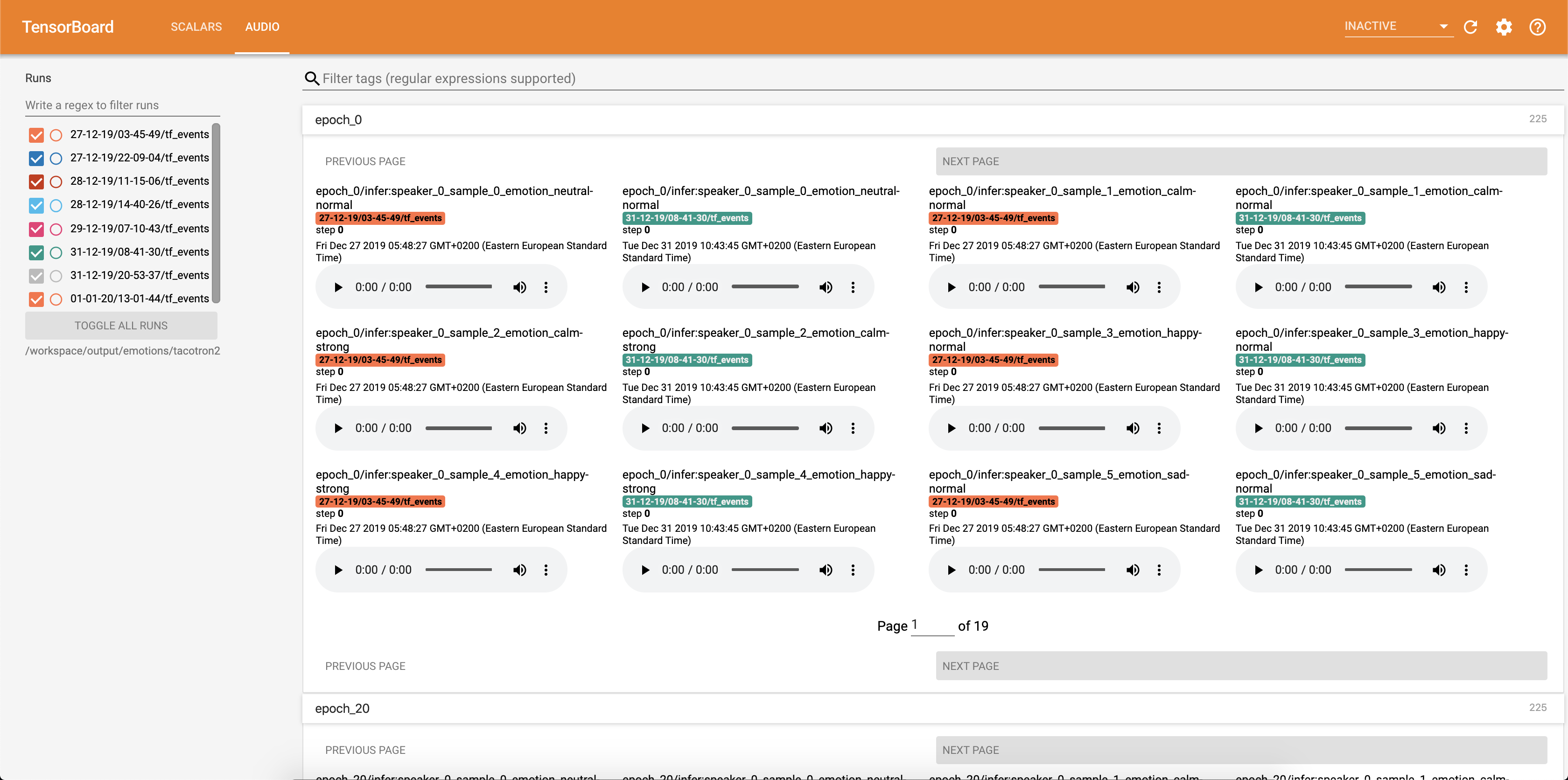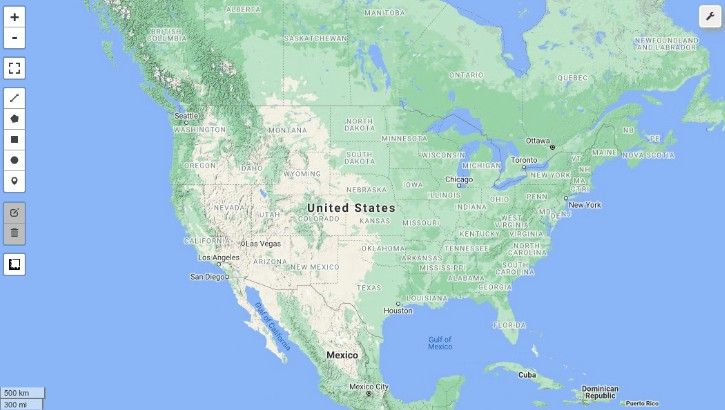tacotron2
Multispeaker & Emotional TTS based on Tacotron 2 and Waveglow
General description
This Repository contains a sample code for Tacotron 2, WaveGlow with multi-speaker, emotion embeddings together with a script for data preprocessing.
Checkpoints and code originate from following sources:
- Nvidia Deep Learning Examples
- Nvidia Tacotron 2
- Nvidia WaveGlow
- Torch Hub WaveGlow
- Torch Hub Tacotron 2
Done:
- [x] took all the best code parts from all of the 5 sources above
- [x] clean the code and fixed some of the mistakes
- [x] change code structure
- [x] add multi-speaker and emotion embendings
- [x] add preprocessing
- [x] move all the configs from command line args into experiment config file under
configs/experimentsfolder - [x] add restoring / checkpointing mechanism
- [x] add tensorboard
- [x] make decoder work with n > 1 frames per step
- [x] make training work at FP16
TODO:
- [ ] make it work with pytorch-1.4.0
- [ ] add multi-spot instance training for AWS
Getting Started
The following section lists the requirements in order to start training the
Tacotron 2 and WaveGlow models.
Clone the repository:
git clone https://github.com/ide8/tacotron2
cd tacotron2
PROJDIR=$(pwd)
export PYTHONPATH=$PROJDIR:$PYTHONPATH
Requirements
This repository contains Dockerfile which extends the PyTorch NGC container
and encapsulates some dependencies. Aside from these dependencies, ensure you
have the following components:
- NVIDIA Docker
- PyTorch 19.06-py3+ NGC container
or newer - NVIDIA Volta or Turing based GPU
Setup
Build an image from Docker file:
docker build --tag taco .
Run docker container:
docker run --shm-size=8G --runtime=nvidia -v /absolute/path/to/your/code:/app -v /absolute/path/to/your/training_data:/mnt/train -v /absolute/path/to/your/logs:/mnt/logs -v /absolute/path/to/your/raw-data:/mnt/raw-data -v /absolute/path/to/your/pretrained-checkpoint:/mnt/pretrained -detach taco sleep inf
Check container id:
docker ps
Select container id of image with tag taco and log into container with:
docker exec -it container_id bash
Code structure description
Folders tacotron2 and waveglow have scripts for Tacotron 2, WaveGlow models and consist of:
<model_name>/model.py- model architecture<model_name>/data_function.py- data loading functions<model_name>/loss_function.py- loss function
Folder common contains common layers for both models (common/layers.py), utils (common/utils.py) and audio processing (common/audio_processing.py and common/stft.py).
Folder router is used by training script to select an appropriate model
In the root directory:
train.py- script for model trainingpreprocess.py- performs audio processing and creates training and validation datasetsinference.ipynb- notebook for running inference
Folder configs contains __init__.py with all parameters needed for training and data processing. Folder configs/experiments consists of all the experiments. waveglow.py and tacotron2.py are provided as examples for WaveGlow and Tacotron 2.
On training or data processing start, parameters are copied from your experiment (in our case - from waveglow.py or from tacotron2.py) to __init__.py, from which they are used by the system.
Data preprocessing
Preparing for data preprocessing
- For each speaker you have to have a folder named with speaker name, containing
wavsfolder andmetadata.csvfile with the next line format:file_name.wav|text. - All necessary parameters for preprocessing should be set in
configs/experiments/waveglow.pyor inconfigs/experiments/tacotron2.py, in the classPreprocessingConfig. - If you're running preprocessing first time, set
start_from_preprocessedflag to False.preprocess.pyperforms trimming of audio files up toPreprocessingConfig.top_db(cuts the silence in the beginning and the end), applies ffmpeg command in order to mono, make same sampling rate and bit rate for all the wavs in dataset. - It saves a folder
wavswith processed audio files anddata.csvfile inPreprocessingConfig.output_directorywith the following format:path|text|speaker_name|speaker_id|emotion|text_len|duration. - Trimming and ffmpeg command are applied only to speakers, for which flag
process_audiois True. Speakers with flagemotion_presentis False, are treated as with emotionneutral-normal. - You won't need
start_from_preprocessed = Falseonce you finish running preprocessing script. Only exception in case of new raw data comes in. - Once
start_from_preprocessedis set to True, script loads filedata.csv(created by thestart_from_preprocessed = Falserun), and formstrain.txtandval.txtout fromdata.csv. - Main
PreprocessingConfigparameters:cpus- defines number of cores for batch generatorsr- defines sample ratio for reading and writing audioemo_id_map- dictionary for emotion name to emotion_id mappingdata[{'path'}]- is path to folder named with speaker name and containingwavsfolder andmetadata.csvwith the following line format:file_name.wav|text|emotion (optional)
- Preprocessing script forms training and validation datasets in the following way:
- selects rows with audio duration and text length less or equal those for speaker
PreprocessingConfig.limit_by(this step is needed for proper batch size) - if such speaker is not present, than it selects rows within
PreprocessingConfig.text_limitandPreprocessingConfig.dur_limit. Lower limit for audio is defined byPreprocessingConfig.minimum_viable_dur - in order to be able to use the same batch size as NVIDIA guys, set
PreprocessingConfig.text_limittolinda_jonson - splits dataset randomly by ratio
train : val = 0.95 : 0.05 - if speaker train set is bigger than
PreprocessingConfig.n- samplesnrows - saves
train.txtandval.txttoPreprocessingConfig.output_directory - saves
emotion_coefficients.jsonandspeaker_coefficients.jsonwith coefficients for loss balancing (used bytrain.py).
- selects rows with audio duration and text length less or equal those for speaker
Run preprocessing
Since both scripts waveglow.py and tacotron2.py contain the class PreprocessingConfig, training and validation dataset can be produced by running any of them:
python preprocess.py --exp tacotron2
or
python preprocess.py --exp waveglow
Training
Preparing for training
Tacotron 2
In configs/experiment/tacotron2.py, in the class Config set:
training_filesandvalidation_files- paths totrain.txt,val.txt;tacotron_checkpoint- path to pretrained Tacotron 2 if it exist (we were able to restore Waveglow from Nvidia, but Tacotron 2 code was edited to add speakers and emotions, so Tacotron 2 needs to be trained from scratch);speaker_coefficients- path tospeaker_coefficients.json;emotion_coefficients- path toemotion_coefficients.json;output_directory- path for writing logs and checkpoints;use_emotions- flag indicating emotions usage;use_loss_coefficients- flag indicating loss scaling due to possible data disbalance in terms of both speakers and emotions; for balancing loss, set paths to jsons with coefficients inemotion_coefficientsandspeaker_coefficients;model_name-"Tacotron2".
- Launch training
- Single gpu:
python train.py --exp tacotron2 - Multigpu training:
python -m multiproc train.py --exp tacotron2
- Single gpu:
WaveGlow:
In configs/experiment/waveglow.py, in the class Config set:
training_filesandvalidation_files- paths totrain.txt,val.txt;waveglow_checkpoint- path to pretrained Waveglow, restored from Nvidia. Download checkopoint.output_directory- path for writing logs and checkpoints;use_emotions- False;use_loss_coefficients- False;model_name-"WaveGlow".
- Launch training
- Single gpu:
python train.py --exp waveglow - Multigpu training:
python -m multiproc train.py --exp waveglow
- Single gpu:
Running Tensorboard
Once you made your model start training, you might want to see some progress of training:
docker ps
Select container id of image with tag taco and run:
docker exec -it container_id bash
Start Tensorboard:
tensorboard --logdir=path_to_folder_with_logs --host=0.0.0.0
Loss is being written into tensorboard:

Audio samples together with attention alignments are saved into tensorbaord each Config.epochs_per_checkpoint. Transcripts for audios are listed in Config.phrases

Inference
Running inference with the inference.ipynb notebook.
Run Jupyter Notebook:
jupyter notebook --ip 0.0.0.0 --port 6006 --no-browser --allow-root
output:
root@04096a19c266:/app# jupyter notebook --ip 0.0.0.0 --port 6006 --no-browser --allow-root
[I 09:31:25.393 NotebookApp] JupyterLab extension loaded from /opt/conda/lib/python3.6/site-packages/jupyterlab
[I 09:31:25.393 NotebookApp] JupyterLab application directory is /opt/conda/share/jupyter/lab
[I 09:31:25.395 NotebookApp] Serving notebooks from local directory: /app
[I 09:31:25.395 NotebookApp] The Jupyter Notebook is running at:
[I 09:31:25.395 NotebookApp] http://(04096a19c266 or 127.0.0.1):6006/?token=bbd413aef225c1394be3b9de144242075e651bea937eecce
[I 09:31:25.395 NotebookApp] Use Control-C to stop this server and shut down all kernels (twice to skip confirmation).
[C 09:31:25.398 NotebookApp]
To access the notebook, open this file in a browser:
file:///root/.local/share/jupyter/runtime/nbserver-15398-open.html
Or copy and paste one of these URLs:
http://(04096a19c266 or 127.0.0.1):6006/?token=bbd413aef225c1394be3b9de144242075e651bea937eecce
Select adress with 127.0.0.1 and put it in the browser.
In this case:
http://127.0.0.1:6006/?token=bbd413aef225c1394be3b9de144242075e651bea937eecce
This script takes
text as input and runs Tacotron 2 and then WaveGlow inference to produce an
audio file. It requires pre-trained checkpoints from Tacotron 2 and WaveGlow
models, input text, speaker_id and emotion_id.
Change paths to checkpoints of pretrained Tacotron 2 and WaveGlow in the cell [2] of the inference.ipynb.
Write a text to be displayed in the cell [7] of the inference.ipynb.
Parameters
In this section, we list the most important hyperparameters,
together with their default values that are used to train Tacotron 2 and
WaveGlow models.
Shared parameters
epochs- number of epochs (Tacotron 2: 1501, WaveGlow: 1001)learning-rate- learning rate (Tacotron 2: 1e-3, WaveGlow: 1e-4)batch-size- batch size (Tacotron 2: 64, WaveGlow: 11)grad_clip_thresh- gradient clipping treshold (0.1)
Shared audio/STFT parameters
sampling-rate- sampling rate in Hz of input and output audio (22050)filter-length- (1024)hop-length- hop length for FFT, i.e., sample stride between consecutive FFTs (256)win-length- window size for FFT (1024)mel-fmin- lowest frequency in Hz (0.0)mel-fmax- highest frequency in Hz (8.000)
Tacotron parameters
anneal-steps- epochs at which to anneal the learning rate (500/ 1000/ 1500)anneal-factor- factor by which to anneal the learning rate (0.1)
These two parameters are used to change learning rate at the points defined inanneal-stepsaccording to:
learning_rate = learning_rate * ( anneal_factor ** p),
wherep = 0at the first step and increments by 1 each step.
WaveGlow parameters
segment-length- segment length of input audio processed by the neural network (8000). Before passing to input, audio is padded or croped tosegment-length.wn_config- dictionary with parameters of affine coupling layers. Containsn_layers,n_chanels,kernel_size.





